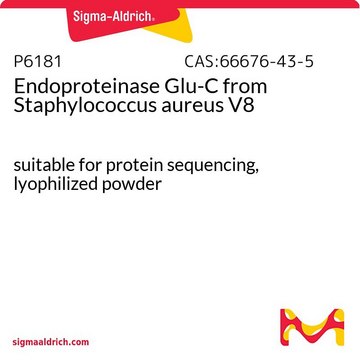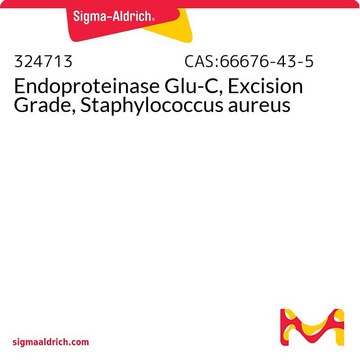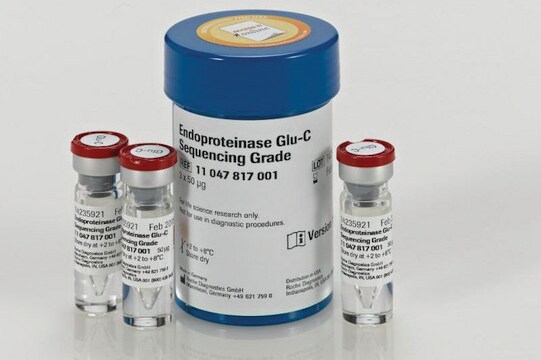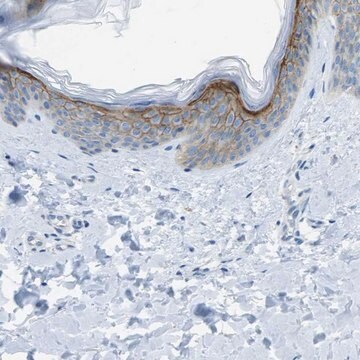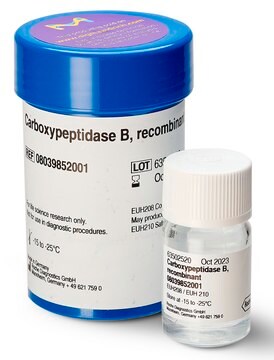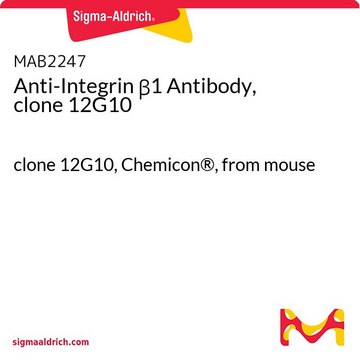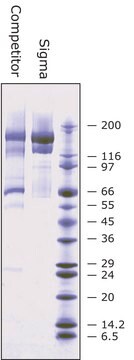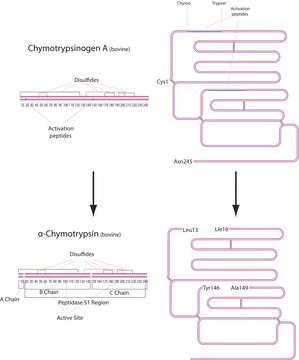10791156001
Roche
Endoproteinase Glu-C (V8 Protease)
from Staphylococcus aureus V8
Sinonimo/i:
V8 protease, protease v8
Autenticatiper visualizzare i prezzi riservati alla tua organizzazione & contrattuali
About This Item
Prodotti consigliati
Stato
lyophilized (salt-free)
Attività specifica
20 U/mg
PM
30 kDa
Confezionamento
pkg of 2 mg
Produttore/marchio commerciale
Roche
pH ottimale
8.0-8.5
Categorie correlate
Descrizione generale
Approximately 20 U/mg lyophilizate at +25°C with Z-Phe-Leu-Glu-4-nitranilide as the substrate (approximately 500 U/mg lyophilizate at +37°C with casein as the substrate).
At 25 °C with Z-Phe-Leu-Glu-4-nitranilide as the substrate (approximately 500 U/mg lyophilizate at 37 °C with casein as the substrate).
Endoproteinase Glu-C is a Staphylococcal serine proteinase. Its inhibitors are DFP, α2-macroglobulin and TLCK.
Specificità
Heat inactivation: Endoproteinase Glu-C is inactivated by boiling for ten minutes.
Applicazioni
Use Endoproteinase Glu-C (V8 Protease) for protein structure analysis and for sequence analysis.
Azioni biochim/fisiol
Endoproteinase Glu-C specifically hydrolyzes peptide and ester bonds at the carboxylic side of Glu, or both Glu and Asp, depending on the buffer used.
Nota sulla preparazione
Activator: The enzyme has its maximal activity in presence of SH-reagents
Working concentration: 1 to 5 mM
Working solution: Recommended solvent is 50 mM ammonium acetate pH 4.0 (2 mg/ml).
Storage conditions (working solution): -15 to -25 °C
The enzyme (2 mg/ml in 50 mM ammonium acetate, pH 4.0) is stable for at least one month, frozen in aliquots and thawed only once.
Working concentration: 1 to 5 mM
Working solution: Recommended solvent is 50 mM ammonium acetate pH 4.0 (2 mg/ml).
Storage conditions (working solution): -15 to -25 °C
The enzyme (2 mg/ml in 50 mM ammonium acetate, pH 4.0) is stable for at least one month, frozen in aliquots and thawed only once.
Stoccaggio e stabilità
Store at 2 to 8 °C. (Store dry!)
Altre note
For life science research only. Not for use in diagnostic procedures.
Avvertenze
Danger
Indicazioni di pericolo
Consigli di prudenza
Classi di pericolo
Eye Irrit. 2 - Resp. Sens. 1 - Skin Irrit. 2 - STOT SE 3
Organi bersaglio
Respiratory system
Codice della classe di stoccaggio
11 - Combustible Solids
Classe di pericolosità dell'acqua (WGK)
WGK 1
Punto d’infiammabilità (°F)
does not flash
Punto d’infiammabilità (°C)
does not flash
Scegli una delle versioni più recenti:
Possiedi già questo prodotto?
I documenti relativi ai prodotti acquistati recentemente sono disponibili nell’Archivio dei documenti.
I clienti hanno visto anche
Rosalynn C Molden et al.
Current protocols in protein science, 77, 23-23 (2014-08-02)
Histones are chromatin proteins that are highly modified with many different types of post-translational modifications. These modifications act in concert to regulate a number of chromatin-related processes. However, identification and quantification of co-occurring histone post-translational modifications is challenging because there
Marion Avril et al.
PLoS pathogens, 9(6), e1003430-e1003430 (2013-07-05)
During blood stage infection, Plasmodium falciparum infected erythrocytes (IE) bind to host blood vessels. This virulence determinant enables parasites to evade spleen-dependent killing mechanisms, but paradoxically in some cases may reduce parasite fitness by killing the host. Adhesion of infected
Tianshi Wang et al.
Molecular cell, 75(4), 823-834 (2019-07-16)
Sirt3, as a major mitochondrial nicotinamide adenine dinucleotide (NAD)-dependent deacetylase, is required for mitochondrial metabolic adaption to various stresses. However, how to regulate Sirt3 activity responding to metabolic stress remains largely unknown. Here, we report Sirt3 as a SUMOylated protein in
Il team dei nostri ricercatori vanta grande esperienza in tutte le aree della ricerca quali Life Science, scienza dei materiali, sintesi chimica, cromatografia, discipline analitiche, ecc..
Contatta l'Assistenza Tecnica.